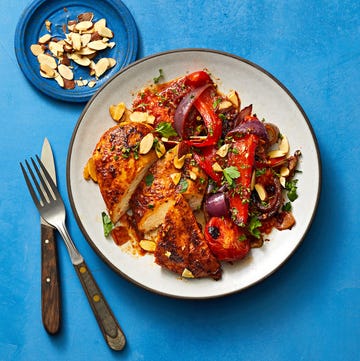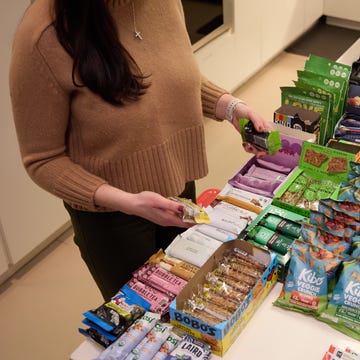1Bulgur
 Svetlana Monyakova//Getty Images
Svetlana Monyakova//Getty ImagesBulgur is a type of cracked wheat that’s a common ingredient in Mediterranean and Middle Eastern dishes, and one cup cooked provides six grams of protein and eight grams fiber. “Bulgur shines in tabbouleh, but its mild taste makes it a perfect addition to soups and chilis, too,” says Michelle Cardel, PhD, MS, RD, chief nutrition officer at Weight Watchers. “You can even sub it in for oatmeal at breakfast.” Bulgur is also a great source of iron, magnesium and manganese.
2Quinoa
 VeselovaElena//Getty Images
VeselovaElena//Getty ImagesThe South American darling (pronounced KEEN-wah) is what’s known as a “pseudo-grain” because it’s technically a seed. It’s covered in a natural coating called saponin, which can make it taste bitter, so be sure to rinse quinoa very well before cooking it. Quinoa is a complete protein, meaning it contains all nine essential amino acids the body needs for various functions but can’t produce on its own, and it's also rich in potassium, an essential player in optimal hydration and antioxidants. One cup cooked quinoa nets you eight grams of protein and five grams fiber. “Enjoy it chilled on top of salads, in stuffed peppers or as a warm breakfast porridge,” Hadley suggests.
RELATED: Quinoa Recipes That'll Help You Eat Healthier All Day Long
Advertisement - Continue Reading Below
3Teff
 ALLEKO//Getty Images
ALLEKO//Getty ImagesYou may be familiar with teff and not know it — because if you've ever eaten Ethiopian cuisine, you’ve had it, as it's used to make injera, the signature spongy flatbread that's used to scoop up the meal. One cup cooked teff contains seven gram of protein and four grams fiber — and like quinoa, it's also a complete, plant-based protein. The fiber and protein content supports balanced blood sugar levels, and teff flour is also a great option for gluten-free baking, says Hadley, adding that “teff can be cooked like and used instead of rice or quinoa in most dishes, as well as in porridge and on salads.”
RELATED: How to Make Injera: An Ethiopian Sour Flatbread from Teff Batter
4Oats
 Arx0nt//Getty Images
Arx0nt//Getty ImagesThe breakfast (and cookie) favorite is a solid source of protein and a type of fiber called beta-glucan, which is particularly good for maintaining a balanced gut microbiome, Hadley says. One cup of cooked oats provides six grams of protein and four grams fiber. Also consider experimenting with oat flour in baking to sneak in more nutrition. “While oats themselves are gluten-free, they are often processed on the same machinery as gluten-containing grains, so if you have celiac or are sensitive to gluten, opt for the gluten-free variety to avoid cross-contamination,” Hadley says.
Advertisement - Continue Reading Below
5Amaranth
 Westend61//Getty Images
Westend61//Getty ImagesLooking for an oatmeal alternative? Amaranth can be cooked just like oats for a fresh twist on breakfast, as its texture is slightly different, says Dana Ellis Hunnes, PhD, MPH, RD, senior clinical dietitian at UCLA Health and assistant professor at UCLA Fielding School of Public Health. One cup cooked amaranth nets you nine grams of protein and five grams fiber. You can also find ready-to-eat popped amaranth for a snack, as well as amaranth flour for baking. Amaranth also packs in your daily manganese needs in just one serving (manganese plays a role in immunity, energy and more), Cardel says, and it's also a rich source of magnesium.
6Buckwheat
 fcafotodigital//Getty Images
fcafotodigital//Getty ImagesDespite its name, buckwheat doesn’t contain any wheat at all, making it a popular grain in gluten-free diets. While buckwheat groats, or kernels, contain a good amount of protein — six grams per cooked cup of buckwheat groats, as well as 4.5 grams fiber — it’s whole-groat buckwheat flour that really shines in this department, clocking in at a hefty 15 grams per cup. You can use it in pancakes or other baked goods, or enjoy soups or stir-frys with soba noodles, which are made from the grain.
Advertisement - Continue Reading Below
7Farro
 BHOFACK2//Getty Images
BHOFACK2//Getty ImagesFarro is an ancient grain that has a lovely, soft and chewy texture, Hadley says. One cup cooked farro contains 6.5 grams of protein and six grams of fiber, as well as B-vitamins, red blood cell-supporting iron and magnesium. When shopping for farro, choose whole instead of pearled or semi-pearled options. Pearling makes grains cook faster by removing part or most of the bran, but that’s where a lot of the nutritional value is found. “Farro makes a delicious base for a rainbow bowl or stir-fry because it soaks up the flavors of the sauces used,” Hadley says.
RELATED: High-Protein Foods to Add to Your Meals, According to Nutritionists
8Sorghum
 Edwin Remsberg//Getty Images
Edwin Remsberg//Getty Images“Sorghum tops the whole grains list when it comes to levels of disease-fighting antioxidants,” Cardel says. "It has a mild, earthy flavor and a chewy texture. Toss it into your favorite salad, or pop it like corn for a crunchy high-protein snack.”
Sorghum is one of the grains with the most protein: One half cup of cooked sorghum delivers 10 grams protein and six grams fiber and it is also high in magnesium, a player in optimal hydration, and vitamin B3, an essential for healthy blood vessels and overall heart health.
Advertisement - Continue Reading Below
9Cornmeal
 fcafotodigital//Getty Images
fcafotodigital//Getty ImagesYes, corn is a grain, not a vegetable, and its nutritional profile is surprisingly robust — one cup of cooked cornmeal contains 10 grams protein and nine grams fiber. “Studies have shown that eating corn may help lower the risk of heart disease and type 2 diabetes, as well as aid in maintaining a healthy weight and improve digestive health,” Hadley adds. Its slightly sweet flavor makes it perfect for cornbread, polenta or pancakes.

Stefani (she/her) is a registered dietitian, a NASM-certified personal trainer and the director of the Good Housekeeping Institute Nutrition and Fitness Lab, where she oversees all nutrition and fitness-related content, testing and evaluation. She holds a master’s degree in clinical nutrition from New York University, as well as advanced certifications as a Women's Fitness Specialist and a Behavior Change Specialist. Stefani is dedicated to providing readers with evidence-based content to encourage informed food choices and healthy living. She is an avid CrossFitter and a passionate home cook who loves spending time with her big fit Greek family.
Advertisement - Continue Reading Below
Readers Also Read
Advertisement - Continue Reading Below
Advertisement - Continue Reading Below





















